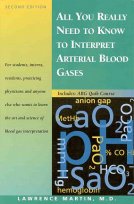
 |
|
|
|
All You Really Need to Know to Interpret Arterial Blood Gases, by Lawrence Martin, MD 1. a, b are correct Incorrect: c) patient may hyperventilate by breathing deeper than normal, or may even hyperventilate with both normal rate and depth if the level of CO2 production falls. d) patient could have metabolic acidosis e) patient is not in a steady state for gas exchange since there is acute hyperventilation 2. a, b, c and e are correct Incorrect: d) In patients who may have lung disease, there are no useful bedside parameters for determining whether PaCO2 is high or low. 3. b, c and e are correct. Incorrect: a) anemia reduces oxygen content, not PaO2 d) carbon monoxide reduces SaO2 and CaO2, not PaO2 4. a and d are correct Incorrect: b, c, and e; you need at least two of the three variables in the Henderson-Hasselbalch equation to assess the acid-base state of a patient's blood. 5. a, b, c and d are correct incorrect: e) In theory, the plasma HCO3- calculated from blood gases should be @ 2-4 mEq/L less than the serum CO2 measured on a venous sample, since venous bicarbonate is higher than arterial and also because serum CO2 measurement includes the quantity contributed by dissolved CO2. 6. a, c, d, e are correct. Incorrect: b) Other determinants are those factors that affect the position of the oxygen-dissociation curve, e.g., temperature, pH, PaCO2 and 2,3 DPG 7. c, d and e are correct Incorrect: a) each gram of hemoglobin can combine with 1.34 ml of O2 b) Normal CaO2 is between 16 and 22 ml O2 /dl 8. a, c and e are correct Incorrect: b) arterial PO2 and pH are not directly related by any equation d) arterial PO2 is related to SaO2 by the O2 dissociation curve, which has a sigmoid configuration 9. b and d are correct Incorrect: a) "hyperventilation" and "hypoventilation" should only be used clinically as they relate to the PaCO2 c) people with normal lungs can increase arterial PO2 above 100 mm Hg with hyperventilation e) a patient can have profound acid-base imbalance yet normal pH from opposing acid-base disorders (e.g., combined metabolic acidosis and metabolic alkalosis) 10. a, b, e are correct Incorrect: c) The pulse oximeter is not equal in accuracy to the co-oximeter, since the latter employs four wavelengths of light to differentiate hemoglobin moieties; the pulse oximeter uses only two wavelengths, and reads carboxyhemoglobin and oxyhemoglobin together. d) The end-tidal PCO2 is usually equal to or lower than the PaCO2. In lung diseases with V-Q imbalance, excess dead space contributes air with low or zero PCO2 to the end-tidal sample, making end-tidal PCO2 lower than PaCO2. |